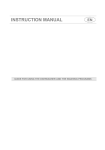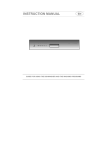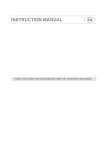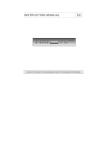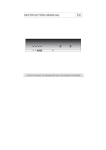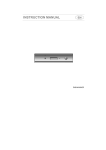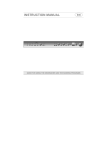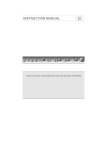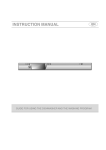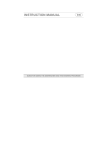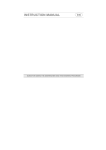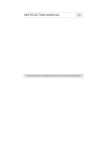Download Smeg DF614FAS7 Instruction Manual
Transcript
INSTRUCTION MANUAL
DISHWASHER
Contents
1.
Safety and operating instructions ___________________________4
2.
Installation and hook-up __________________________________7
3.
Description of the controls________________________________10
4.
Operating instructions ___________________________________16
5.
Cleaning and maintenance _______________________________29
6.
Troubleshooting _______________________________________33
Thank you for choosing this product.
We advise you to carefully read all the instructions contained in this
manual, in order to understand how to operate your dishwasher safely
and correctly.
The manual is divided into paragraphs, which provide a step by step
description of the dishwasher functions, with clear instructions
accompanied by detailed illustrations.
Recommendations are given for the correct use of the baskets, spray
arms, containers, filters, washing programs, and for operating the
controls.
Follow the recommended cleaning procedures to ensure that your
dishwasher always remains in perfect working order.
This manual provides a quick and easy reference for answering all your
questions concerning the use of your new dishwasher.
INSTALLATION INSTRUCTIONS: these are intended for the qualified
technician who must carry out the installation, hook-up and testing of
the appliance.
USER INSTRUCTIONS: these consist of recommendations for using the
appliance, a description of its controls and of the correct cleaning and
maintenance procedures.
Safety instructions
1. Safety and operating instructions
THIS MANUAL FORMS AN INTEGRAL PART OF THE APPLIANCE: IT MUST
ALWAYS BE KEPT INTACT TOGETHER WITH THE DISHWASHER. BEFORE
USING THE APPLIANCE, CAREFULLY READ ALL THE INSTRUCTIONS
CONTAINED IN THIS MANUAL.
INSTALLATION MUST BE PERFORMED BY A QUALIFIED TECHNICIAN, IN
COMPLIANCE WITH THE REGULATIONS IN FORCE. THIS APPLIANCE IS
INTENDED FOR DOMESTIC USE, AND COMPLIES WITH THE EEC
DIRECTIVES 72/23, 89/336 (INCLUDING 92/31) CURRENTLY IN FORCE,
INCLUDING THE PREVENTION AND ELIMINATION OF RADIO FREQUENCY
INTERFERENCE.
THE APPLIANCE IS DESIGNED FOR THE FOLLOWING PURPOSE: WASHING
AND DRYING OF DISHES; ANY OTHER USE SHALL BE CONSIDERED
IMPROPER. THE MANUFACTURER DECLINES ALL RESPONSIBILITY FOR
USES OTHER THAN THOSE DESCRIBED ABOVE.
THE NAME PLATE FEATURING THE TECHNICAL DATA, SERIAL NUMBER
AND MARKINGS IS VISIBLY POSITIONED ON THE INNER EDGE OF THE
DOOR. THE NAME PLATE ON THE INNER EDGE OF THE DOOR MUST
NEVER BE REMOVED.
DO NOT LEAVE THE DISCARDED PACKAGING MATERIALS UNSUPERVISED
WITHIN THE HOME. SEPARATE THE VARIOUS MATERIALS WHICH MAKE
UP THE PACKAGING AND TAKE THEM TO THE NEAREST SORTED WASTE
COLLECTION CENTRE.
THE APPLIANCE MUST BE PROVIDED WITH AN EARTH CONNECTION IN
ACCORDANCE WITH THE ELECTRICAL SAFETY REGULATIONS IN FORCE.
THE MANUFACTURER DECLINES ALL RESPONSIBILITY FOR DAMAGE TO
PERSONS OR PROPERTY RESULTING FROM THE FAILURE TO EARTH THE
APPLIANCE OR FROM A DEFECTIVE EARTH CONNECTION.
IF THE APPLIANCE IS INSTALLED ON A CARPETED OR COVERED FLOOR,
ENSURE THAT THE OPENINGS ON ITS UNDERSIDE ARE NOT
OBSTRUCTED.
ALWAYS SWITCH OFF THE DISHWASHER AFTER EACH USE TO AVOID
WASTING ELECTRICITY.
OBSOLETE APPLIANCES MUST BE RENDERED UNUSABLE. CUT OFF THE
MAINS POWER CORD AFTER UNPLUGGING IT FROM THE WALL OUTLET,
AND MAKE SAFE ANY COMPONENTS WHICH MIGHT BE DANGEROUS FOR
CHILDREN (LOCKS, DOORS, ETC.).
Safety instructions
THIS APPLIANCE IS MARKED ACCORDING TO THE EUROPEAN DIRECTIVE
2002/96/EC ON WASTE ELECTRICAL AND ELECTRONIC EQUIPMENT
(WEEE). BY ENSURING THIS PRODUCT IS DISPOSED OF CORRECTLY,
YOU WILL HELP PREVENT POTENTIAL NEGATIVE CONSEQUENCES FOR
THE ENVIRONMENT AND HUMAN HEALTH, WHICH COULD OTHERWISE BE
CAUSED BY INAPPROPRIATE WASTE HANDLING OF THIS PRODUCT.
ON THE PRODUCT, OR ON THE DOCUMENTS
THE SYMBOL
ACCOMPANYING THE PRODUCT, INDICATES THAT THIS APPLIANCE MAY
NOT BE TREATED AS HOUSEHOLD WASTE. INSTEAD IT SHALL BE
HANDED OVER TO THE APPLICABLE COLLECTION POINT FOR THE
RECYCLING OF ELECTRICAL AND ELECTRONIC EQUIPMENT.
DISPOSAL MUST BE CARRIED OUT IN ACCORDANCE WITH LOCAL
ENVIRONMENTAL REGULATIONS FOR WASTE DISPOSAL. FOR MORE
DETAILED INFORMATION ABOUT TREATMENT, RECOVERY AND
RECYCLING OF THIS PRODUCT, PLEASE CONTACT YOUR LOCAL CITY
OFFICE, YOUR HOUSEHOLD WASTE DISPOSAL SERVICE OR THE SHOP
WHERE YOU PURCHASED THE PRODUCT.
IN THE EVENT OF A FAULT, DISCONNECT THE DISHWASHER FROM THE
ELECTRICAL POWER SUPPLY AND SHUT OFF THE WATER TAP.
DO NOT USE APPLIANCES WHICH HAVE BEEN DAMAGED DURING
TRANSIT! IF IN DOUBT, CONSULT YOUR DEALER.
THE APPLIANCE MUST BE INSTALLED AND CONNECTED IN ACCORDANCE
WITH THE INSTRUCTIONS PROVIDED BY THE MANUFACTURER OR BY A
QUALIFIED TECHNICIAN.
THE APPLIANCE IS INTENDED FOR USE BY ADULTS. DO NOT ALLOW
CHILDREN TO COME NEAR OR PLAY WITH THE DISHWASHER. KEEP
CHILDREN AWAY FROM DETERGENTS AND FROM THE OPEN
DISHWASHER DOOR. THE PACKAGING MATERIALS (PLASTIC BAGS,
POLYSTYRENE, METAL BARS, ETC.) MUST NOT BE LEFT WITHIN THE
REACH OF CHILDREN.
KEEP CHILDREN AWAY FROM THE OPEN DISHWASHER. THE APPLIANCE
MAY CONTAIN RESIDUES OF DETERGENT WHICH CAN CAUSE
IRREVERSIBLE DAMAGE TO THE EYES, MOUTH, AND THROAT, AS WELL
AS POSSIBLE DEATH BY SUFFOCATION.
DO NOT INTRODUCE SOLVENTS SUCH AS ALCOHOL OR TURPENTINE
WHICH MAY CAUSE AN EXPLOSION.
DO NOT LOAD DISHES THAT ARE SOILED WITH ASH, WAX OR PAINTS.
LEANING OR SITTING ON THE DISHWASHER DOOR WHEN OPEN MAY
CAUSE THE APPLIANCE TO OVERTURN, PUTING PEOPLE AT RISK.
NEVER LEAVE THE DISHWASHER DOOR OPEN; PEOPLE MIGHT TRIP
OVER IT.
Safety instructions
DO NOT DRINK THE WATER RESIDUES WHICH MAY BE PRESENT INSIDE
THE DISHES OR DISHWASHER AT THE END OF THE WASHING PROGRAM
AND BEFORE THE DRYING CYCLE.
KNIVES OR OTHER SHARP-ENDED COOKING UTENSILS MUST BE PLACED
IN THE CUTLERY BASKET BLADE-DOWN, OR LAID HORIZONTAL IN THE
TOP BASKET. TAKE CARE NOT TO CUT YOURSELF AND ENSURE THAT
THEY DO NOT PROJECT FROM THE BASKET.
AQUASTOP MODELS
THE AQUASTOP DEVICE PREVENTS FLOODING IN THE EVENT OF A
WATER LEAK. WHEN THE AQUASTOP DEVICE IS TRIPPED, CALL IN A
QUALIFIED TECHNICIAN TO IDENTIFY AND REPAIR THE FAULT.
IN MODELS EQUIPPED WITH THE AQUSTOP DEVICE, THERE IS A
SOLENOID VALVE INSIDE THE WATER INTAKE HOSE. DO NOT CUT THE
HOSE AND DO NOT ALLOW THE SOLENOID VALVE TO DROP INTO
WATER. IN THE EVENT OF DAMAGE TO THE WATER INTAKE HOSE,
DISCONNECT THE APPLIANCE FROM THE ELECTRICAL POWER SUPPLY
AND FROM THE WATER SUPPLY.
IMMEDIATELY AFTER INSTALLING THE DISHWASHER, PERFORM A QUICK
TEST OF THE APPLIANCE FOLLOWING THE INSTRUCTIONS BELOW. IF
THE DISHWASHER FAILS TO OPERATE CORRECTLY, DISCONNECT IT
FROM THE ELECTRICAL POWER SUPPLY AND CALL THE NEAREST
TECHNICAL SERVICE CENTRE. DO NOT ATTEMPT TO REPAIR THE
APPLIANCE.
THE DISHWASHER MEETS ALL THE REQUIREMENTS SET OUT BY THE
REGULATIONS IN FORCE CONCERNING SAFETY AND ELECTRICAL
EQUIPMENT. ANY TECHNICAL CHECKS SHOULD BE CONDUCTED
EXCLUSIVELY BY A TRAINED AND AUTHORISED TECHNICIAN: REPAIRS
CARRIED OUT BY UNAUTHORISED PERSONS WILL INVALIDATE THE
WARRANTY, AS WELL AS POSING A POTENTIAL HAZARD TO THE USER.
The manufacturer declines all responsibility for damage to persons or property
resulting from failure to observe the above precautions, from tampering with
even a single component of the appliance, or from the use of non original
spare parts.
Installation instructions
2. Installation and hook-up
Remove the polystyrene basket retainers.
Position the appliance in the desired place of installation. The back or
sides of the dishwasher may be placed up against walls or other
furniture units. If the dishwasher is installed near a heat source, fit the
special insulating panel to prevent overheating and malfunction of the
appliance. To ensure stability, install integrated or built-under
dishwashers only under continuous worktops, and screw them to the
adjacent units. To facilitate the installation procedure, the intake and
drain hoses can be positioned in any direction; make sure that the hoses
are not kinked, crushed or pulled too tightly. Make sure to tighten the
locking ring-nut once the pipes have been placed in the direction
required. A hole at least 8 cm in diameter is required to allow the power
supply cable and pipes to pass.
Level the appliance on the floor using its adjustable feet. This operation
is essential for ensuring correct operation of the dishwasher.
Building-in a dishwasher underneath a ceramic hob is absolutely
forbidden.
A dishwasher can be built-in underneath a conventional hob provided
there is no break in the kitchen worktop, and the dishwasher and hob
are installed and secured correctly, so that no hazards are
generated.
For free-standing models only
- Installing a hob on top of a free-standing dishwasher is absolutely
forbidden.
- If the appliance is not built-in and is therefore accessible on one
side, the door hinge area must be covered for safety reasons (injury
hazard). The covering fixtures are available as an accessory from
specialist dealers or the After-Sales Service.
- To build in the dishwasher, the special kit must be purchased from
authorised dealers or the After-Sales Service.
Installation instructions
2.1 Water supply connection
Preventing the risk of clogging or damage: if the water pipe is new or
has not been used for a long time, before connecting to the water supply
check that the water is clear and free of impurities, to prevent damage to
the appliance. The dishwasher must always be connected to the water
system with new hoses; old or used hoses must never be reused.
CONNECTING TO THE WATER SUPPLY
Connect the intake hose to a cold water supply with ¾”
gas thread, inserting the filter A supplied with the
dishwasher. Take care to screw the hose firmly into
place with your hands and then complete by
tightening about ¼ of a turn with pliers.
In dishwashers equipped with the ACQUASTOP
device, the filters is already fitted inside the threaded
ring.
The dishwasher can also be connected to a hot water supply not
exceeding 60°C. Supplying the appliance with hot water cuts down the
washing time by approximately 20 minutes, but slightly reduces its
effectiveness. Make the connection to the domestic hot water supply using
the same procedure described for connecting to the cold water supply.
DRAIN CONNECTION
Insert the dishwasher’s drain hose
into a drain pipe having a diameter
of at least 4 cm, or alternatively,
place it inside the kitchen sink
using the plastic support provided,
taking care not to crush or
excessively bend the hose. It is
important to prevent the hose from
coming loose and falling. For this
purpose, the plastic support is
equipped with a hole for tying it to
the wall or water tap.
The free end should be positioned at a height of between 30 and 100
cm, and should never be submerged in water. If a horizontal drain
extension hose is used (for a maximum of 3 m) the drain hose can be
placed at a maximum height of 85 cm from the ground.
Installation instructions
2.2 Electrical connection and precautions
CHECK THAT THE VOLTAGE AND THE FREQUENCY OF THE MAINS MATCH
THE RATINGS ON THE NAME PLATE OF THE APPLIANCE POSITIONED ON
THE INNER EDGE OF THE DOOR.
THE PLUG ON THE SUPPLY CORD AND THE CORRESPONDING SOCKET
OUTLET MUST BE OF THE SAME TYPE AND MEET THE REGULATIONS IN
FORCE.
THE PLUG MUST BE ACCESSIBLE AFTER INSTALLATION.
NEVER DISCONNECT THE PLUG BY PULLING ON THE POWER SUPPLY
LEAD.
IN THE EVENT OF DAMAGE TO THE SUPPLY CORD, HAVE IT REPLACED
BY THE MANUFACTURER OR AN AUTHORIZED TECHNICAL SERVICE
CENTRE.
DO NOT USE ADAPTORS OR SHUNT CONNECTIONS IN ORDER TO AVOID
THE POSSIBILITY OF OVERHEATING OR BURNING.
In the event of damage to the supply cord, have it replaced by the
manufacturer or an Authorized Technical Service Centre in order to
avoid any risk.
User instructions
3. Description of the controls
3.1 Front panel
All the dishwasher control are grouped on the front panel. Programming
and option selection are only possible with the door closed.
1
ON/OFF BUTTON
2
START/PAUSE BUTTON
3
SELECTION PROGRAMS BUTTON
4
PROGRAMS LIGHTS
5
½ LOAD WASH BUTTON (on some models only)
6
½ LOAD WASH LIGHT (on some models only)
7
NO SALT LIGHT
8
NO RINSE AID LIGHT
9
RECESSED DOOR HANDLE
User instructions
SETTING THE WASHING PROGRAM
To select the most suitable program for the dishes to be washed refer to
the table below, which indicates the most appropriate program according
to dish type and degree of soiling.
PROGRAM
SELECTION
TYPE AND GRADE DIRT
PROGRESS
PROGRAM
DURATION
CONSUMPTION
MINUTES
(2)
WATER
LITRES (1)
POWER
KWh (2)
SOAK
PANS AND DISHES
IN WAITING OF
COMPLETING
THE LOAD
Cold prewash
15'
6
0,03
LIGHT
DISHES
NOT VERY DIRTY
Wash at 45°C
Cold rinse
Rinse at 68°C
Dry
70'
15
1,15
BIO
(*)
PANS AND DISHES
NOT VERY DIRTY BUT
WITH DRY RESIDUALS
180'
17
1,08
NORMAL
PANS AND DISHES
DIRTY AND WITH
DRY RESIDUALS
100'
20
1,40
SUPER
PANS AND DISHES
VERY DIRTY AND
WITH DRY RESIDUALS
115'
24
1,77
Cold prewash
Wash at 50°C
Cold rinse
Rinse at 62°C
Dry
Cold prewash
Wash at 65°C
Cold rinse
Rinse at 68°C
Dry
Prewash at 45°C
Wash at 70°C
2 cold rinses
Rinse at 70°C
Dry
Only run the soak program with half loads.
The HALF LOAD option (5) is available for all programs except the soak program.
(*) Reference program as per EN 50242 standard.
(1) Average power consumption with the softener set on level 2.
(2) The cycle duration and power consumption may vary according to the water and room
temperatures, and the type and amount of dishes.
The washing cycle will not take place if the dishwasher door is left open
or not properly closed.
User instructions
TABLE FOR CERTIFICATION BODIES
Reference standard
Reference program
Load
Type of detergent
Amount of detergent
Rinse aid setting
EN 50242
BIO
14 place-settings
B
35 g
5/6
3.2 Washing programs
The dishwasher is equipped with a control panel, described in chapter
"3. Description of the controls", from which it is possible to carry out all
the power switch-on, switch-off and programming operations.
Before starting a washing program make sure that:
•
The water supply tap is open.
•
The correct amount of detergent has been added to the
dispenser.
•
The baskets have been correctly loaded.
•
The spray arms are able to rotate freely and without
obstruction.
•
The dishwasher door is securely closed.
User instructions
SWITCHING ON
When the ON/OFF button (1) is pressed, the dishwasher switches on.
The indicator lights will display the dishwasher's "status".
PROGRAMMING
Programming operations are only possible with the door closed.
As long as the door is open, the PROGRAMS (4) lights remain off.
PROGRAM SELECTION
Press the PROGRAM SELECTION
button (3) several times until the light of
the program required comes on.
STARTING THE PROGRAM
To start the dishwasher, press the START/PAUSE button (2) for a few
seconds, until the light of the selected program starts to flash
(confirmation beep).
The light will flash as long as the program is in progress, to indicate that
it is being performed.
END OF PROGRAM
At the end of the program the beeper
sounds briefly and the program lights 4
and 5 (marked "end") flash.
User instructions
INTERRUPTION A PROGRAM
To interrupt a program in progress:
•
•
press the START/PAUSE button (2); the light of the program in
progress remains on (confirmation beep);
you may now restart the program by pressing button (2) again until it
restarts, or change or annul the program (see "CHANGING A
PROGRAM", or "ANNULLING A PROGRAM").
CHANGING A PROGRAM
To change the running program it is necessary:
•
•
•
to interrupt the running program (see “INTERRUPTION A PROGRAM”);
select the new program;
start the program (see “STARTING THE PROGRAM”).
ANNULLING A PROGRAM
To annul the program, keep the START/PAUSE button (2) pressed until
the program is interrupted (light on and confirmation beep).
Press button (2) again and keep it
pressed until the lights 4 and 5 (marked
"end") come on.
The water in the tank will be pumped out and the program will end at the
point where it was interrupted.
In case that the door is opened during the operation, to the next door
closing it is going to be necessary to start the program as shown in
paragraph “STARTING THE PROGRAM”. The program will resume from the
point in which it was interrupted.
In case that the tub temperature is higher than 50°C the program
will start about 30 seconds later.
User instructions
HALF LOAD WASH SETTING (certain models only)
(available in all programs except the soak program)
This function is ideal for small loads and saves
water and electricity. It is controlled by the HALF
LOAD button (5) and allows washing in the upper
basket only.
IMPORTANT: at the end of the program remember
to deactivate the function to ensure the next
wash is not also carried out in half load mode by
mistake.
TO SAVE ON ENERGY! … AND PROTECT THE ENVIRONMENT
•
•
•
•
•
Always try to run the dishwasher fully loaded.
Do not wash the dishes in running water.
Use the washing program that is most appropriate for each type of
load.
Do not carry out any preliminary rinsing.
If available, connect the dishwasher to a hot water supply up to
60°C.
TO CUT DOWN ON DETERGENT CONSUMPTION! … AND PROTECT
THE ENVIRONMENT
The phosphates contained in dishwasher detergents are harmful to the
environment. To avoid using excessive amounts of detergent and to
save on electricity, observe the following:
•
•
separate the more delicate items from dishes that are more
resistant to aggressive detergents and high temperatures;
do not pour the detergent directly on the dishes.
REMOVING THE DISHES
At the end of the washing program, wait at least 20 minutes before
removing the dishes, to allow them to cool down. To prevent any water
droplets on the upper basket from falling on the dishes in the lower
basket, it is advisable to unload the lower basket first, and then the
upper basket.
15
User instructions
4. Operating instructions
Once the dishwasher has been correctly installed, prepare for use as
follows:
•
•
•
Adjust the water softening system;
Add the regenerating salt;
Add the rinse aid and detergent.
4.1 Using the water softening system
The amount of scale contained in the
water (water hardness index) can cause
whitish staining on the dry dishes, which
tend to become dull over time. The
dishwasher is equipped with an automatic
softening system which uses a special
regenerating salt to reduce the hardness
of the water.
The dishwasher is factory set for water
hardness level 3 (average hardness
41-60°dF – 24-31°dH).
SALT
When using water of medium hardness, the regenerating salt container
should be refilled after approximately 20 washing cycles. The salt
container can hold approximately 1.7 Kg of salt in grains. Some models
are equipped with an optical no-salt indicator. In these models, the cap
of the salt container contains a green float which descends as the salt
concentration in the water drops. When the green float can no longer be
seen through the transparent cap, the container must be topped up with
regenerating salt. The container is situated at the bottom of the
dishwasher. After removing the lower basket, unscrew the salt container
cap by turning it anticlockwise and pour in the salt using the funnel
supplied with the dishwasher. Before replacing the cap, remove any salt
residues from around the opening.
•
•
•
16
When using the dishwasher for the first time, in addition to the salt it
is also necessary to add one litre of water to the container.
Each time the salt container is refilled, make sure that the cap is
securely closed. The mixture of water and detergent must never
penetrate the salt container, as this would compromise the operation
of the regeneration system. In the event of this occurring, the
warranty will be invalidated.
Only use regenerating salt specially formulated for domestic
dishwashers. If using salt tablets, do not fill the container
completely.
User instructions
•
Do not use table salt as it contains insoluble substances which,
over time, may damage the water softening system.
•
When necessary, refill the regenerating salt container before
starting the washing program. In this way, the excess saline
solution will be immediately removed by the water; the prolonged
presence of salt water inside the tank may lead to corrosion.
Be careful not to confuse the salt and detergent packages; adding
detergent to the salt container will damage the water softening system.
ADJUSTING THE WATER SOFTENING SYSTEM
The dishwasher is equipped with an device for the user to adjust the
water softening system according to the hardness of the water supply.
According to the machine model, the selector which acts on the
adjustment may be located:
•
•
inside the plastic locking ring located on the right-hand side, inside
the dishwasher;
inside the water softener, just below the cap.
Both allow for adjustment to 5 settings:
17
User instructions
WATER HARDNESS TABLE
WATER HARDNESS
German Degrees (°dH)
French Degrees (°dF)
0-4
5 - 15
16 - 23
24 - 31
32 - 47
48 - 58
0-7
8 - 25
26 - 40
41 - 60
61 - 80
81 - 100
SETTING
Setting N. 1 NO SALT
Setting N. 1
Setting N. 2
Setting N. 3
Setting N. 4
Setting N. 5
Contact your local water board for information on the hardness of your
water supply.
4.2 Using the rinse aid and detergent dispensers
The detergent and rinse aid
dispensers are situated on the inner
part of the door: the detergent
dispenser is on the left, and the
rinse aid dispenser is on the right.
With the exception of the SOAK program, before every washing cycle it
is necessary to add the required amount of detergent to the detergent
dispenser. The rinse aid, on the other hand, should only be added as
required.
18
User instructions
ADDING THE RINSE AID
The rinse aid helps the dishes dry faster and
prevents the formation of scale deposits and
staining; it is automatically added to the water
during the final rinse cycle, from the container
situated on the inner side of the door.
To add rinse aid:
•
Open the door.
•
Rotate the container cap anticlockwise by ¼ of a turn and remove it.
•
Add the rinse aid until the container is full (approximately 140 cc).
The optical level indicator on the side of the cap should be
completely obscured. Refill the rinse aid when the optical level
indicator becomes clear again, or when the rinse aid warning light
illuminates.
•
Replace the cover and turn it in a clockwise direction.
•
Use a cloth to remove any spillage of rinse aid which might lead to
the formation of excess foam.
ADJUSTING THE RINSE AID DISPENSER SETTING
The dishwasher is factory set for medium water hardness. However it
possible to change the setting by turning the dispenser’s selector to the
desired position: the amount of rinse aid dispensed is proportional to the
selector position.
•
•
•
•
•
To adjust the rinse aid setting, rotate the dispenser cap through a
quarter turn in an anticlockwise direction and remove it.
Then use a screwdriver to rotate the rinse aid selector to the desired
position.
Replace the cap, turning it clockwise.
The amount of rinse aid must be increased if the washed dishes
appear dull or feature circular stains.
If, on the other hand, the dishes are sticky or have white streaks, it
is necessary to reduce the rinse aid setting.
19
User instructions
ADDING THE DETERGENT
To open the detergent dispenser cap, lightly press
the button P. Add the detergent and close the cap
carefully.
During the washing cycle, the dispenser will be
opened automatically.
20
•
When a SUPER program is selected, in addition to the normal dose
of detergent, it is necessary to add an additional amount inside
compartment G or H.
•
Use only detergents specially formulated for dishwashers. For
optimal washing results it is important to use a good quality
detergent.
•
The detergent packs must be sealed and stored in a dry place to
prevent the formation of lumps which may negatively affect washing
results. Once opened the detergent packs should not be kept for too
long, otherwise the detergent loses its effectiveness.
•
Do not use detergents formulated for washing dishes by hand,
because they produce a great deal of foam and may negatively
affect the operation of the dishwasher.
•
Add the correct amount of detergent. An insufficient amount of
detergent will result in a partial removal of dirt from the dishes,
whereas an excessive amount is wasteful and does not improve the
washing results.
User instructions
•
The market offers liquid and powder detergents with differing
chemical compositions, which may contain phosphates, or be
phosphate-free but contain natural enzymes.
- Detergents containing phosphates are more effective against
grease and starch at temperatures above 60°C.
- Enzyme detergents, on the other hand, are also effective at lower
temperatures (from 40 to 55°C) and are more easily
biodegradable. With enzyme detergents it is possible to obtain at
low temperatures comparable results to those which can only be
achieved at 65°C using traditional detergents.
For the safeguarding of the environment we recommend the use of
phosphate- and chlorine free detergents.
•
Also available are tablet detergents which state that that no salt or
rinse aid is required. In some cases, these detergents might not give
good results, especially with short and/or low-temperature washing
cycles.
If performance problems (e.g. a white coating on the tank or dishes,
poor drying, dirt on dishes at the end of the wash) are noted, users
are advised to return to conventional products (granular salt, powder
detergent and liquid rinse aid).
However, please note that on return to the use of conventional salt,
a number of cycles will be required before the system becomes fully
efficient again, so traces of white coating may still be found on the
tank and dishes. If the problem persists for too long, contact the
After-Sales Service.
•
When using detergent in tablet form (bear in mind that we
recommend the use of three separate products: detergent, salt and
rinse aid), place the tablets in the cutlery rack. The dispenser is
designed to use powder or liquid detergent and the door does not
open completely during the washing cycle. This means that a tablet
is not completely dissolved (released), which may lead to the
following:
- not enough detergent released during the cycle, with poor washing
results;
- the detergent forms a solid block in the distributor and is released
during the final rinse cycle.
The introduction of detergent into the rinse aid dispenser, even in
liquid form, will damage the dishwasher.
21
User instructions
4.3 General warnings and recommendations
Before using the dishwasher for the first time, it is advisable to read the
following recommendations concerning dish types to be washed and
their loading.
There are generally no constraints on the washing of domestic dishes,
but in certain cases it is necessary to take their characteristics into
account.
Before loading the dishes into the baskets it is necessary to:
•
remove coarse food remains: e.g. bones, fish-bones, etc. which
may clog the filter or damage the wash pump.
•
soak any pots or pans with burnt-on food remains on the bottom to
facilitate removal, then load them into the LOWER BASKET.
If a small quantity of dishes has to be washed, use the “½ load wash”
option; this saves electricity and water.
Remember to load the upper basket only; the lower basket must
be left empty.
There is no need to pre-wash the dishes under running water before
loading them into the baskets since this only wastes water.
Correct loading of the dishes helps ensure optimal washing
results.
WARNING!
•
•
•
•
•
Make sure that the dishes are securely in place so that they cannot
tip over or obstruct the rotation of the spray arms during the
washing cycle.
Do not place very small objects in the baskets as these could fall
and obstruct the spray arms or the wash pump.
Containers such as cups, bowls, glasses and pots should always
be loaded with the opening facing downwards and with any cavities
at an angle, to allow the water to drain out.
Do not stack dishes or place them in such a way that they cover
one other.
Do not place glasses too close together because they may knock
against each other and break, or there might be staining at the
point where they touch.
MAKE SURE that the items being washed are dishwasher-safe.
22
User instructions
Items which are not dishwasher-safe:
•
•
•
•
•
•
•
•
Wooden dishes, pots or pans: these may be damaged by the
high washing temperatures.
Handcrafted items: these are rarely suitable for washing in a
dishwasher. The relatively high water temperatures and the
detergents used may damage them.
Plastic dishes: heat resistant plastic dishes must be washed in the
upper basket.
Dishes and objects in copper, tin, zinc or brass: these tend to
stain.
Aluminium dishes: items made from anodised aluminium may
lose their colour.
Silverware: silver items may stain.
Glass and crystal: in general, glass and crystal objects can be
washed in the dishwasher. However, certain types of glass and
crystal may become dull and lose their clearness after many
washings. Therefore, for these items we recommend using the
least aggressive program available.
Decorated items: the decorated objects available on the market
are generally able to withstand washing in the dishwasher,
although the colours may fade after a great many washes. If in
doubt as to the fastness of the colours, it is advisable to wash just a
few items at a time for approximately one month.
23
User instructions
4.4 Using the baskets
The dishwasher has a capacity of 14 place-settings, including serving
dishes.
EN 50242 STANDARD LOADS FOR CERTIFICATION BODIES
LOWER BASKET
UPPER BASKET
EN 50242 cycle test conditions:
Lower basket: the grid "A" ("lower basket" section) must not be raised.
Upper basket: on the left, there are two saucers underneath the cups.
LOWER BASKET
The lower basket receives the full force of the lower spray arm, and
should therefore be used for the “toughest” items with a heavier degree
of soiling. All types and combinations of loads are permitted, provided
that the dishes, pots and pans are arranged with all the soiled surfaces
exposed to the water jets coming from the bottom.
The rear of the basket is fitted with a rack to take large plates (A). To
use it, simply lift it until it locks in place.
24
User instructions
In the front there are one or two supports (depending on the models) for
small plates (B). To use them, they have to be turned towards the front
of the dishwasher.
LOADING THE LOWER BASKET
Carefully load flat plates, soup plates, dessert and serving dishes,
positioning them vertically. Pots, pans and their covers must be loaded
upside down. When loading soup plates and dessert bowls, be sure to
leave a gap between them.
Loading examples:
½ LOAD
25
User instructions
CUTLERY BASKET
Cutlery must be placed with the tips facing downward.
Long items of cutlery (ladles, wooden spoons, kitchen knives, etc.),
which might interfere with the upper spray arm must be placed in the
upper basket, ensuring that knife tips do not project from the basket.
The cutlery basket features an exclusive system of independent
sliding tip-up supports, offering a series of combinations to allow
optimum use of the space available.
/QXGOGPVTGSWKTGF
VQGZVTCEVVJGKPUGTVU
Vertical
inserts
*QTK\QPVCN
KPUGTVENQUGF
Horizontal
insert
open
It can also be separated into two parts, particularly useful when carrying
out a ½ load wash (on models with this function).
26
User instructions
UPPER BASKET
It is recommended to load the upper basket with small- or medium-sized
items such as glasses, small plates, tea or coffee cups, shallow bowls
and light objects made from heat resistant plastic. If the upper basket is
used in the lowermost position, it can also be loaded with serving dishes,
provided they are only slightly soiled.
The top basket is fitted (on the left)
with two plastic racks which can be
raised to make room for tall glasses,
such as stem glasses.
On the right there are two cutlery
racks designed to take knives and
teaspoons; when not in use, they can
be left vertical, attached to the
basket.
To use the space designed for
teaspoons, remove the insert as
shown in the illustrations.
LOADING THE UPPER BASKET
Load plates facing forward; cups, bowls etc. must always be facing
downwards. The left-hand side of the basket can be loaded with two
layers of cups and glasses. The centre can be filled with plates and sideplates, fitted upright into the supports provided.
Loading examples:
½ LOAD
27
User instructions
ADJUSTING THE UPPER BASKET
The upper basket can be adjusted in two positions, according to the
user’s needs and according to the height of the dishes in the lower
basket.
Proceed as follows:
•
•
•
•
•
28
pull out the right-hand basket guide;
remove the stop, first releasing it as shown in the diagram;
push the guide to free the wheels;
fit the upper or lower pair of wheels into the guide, depending on the
setting required;
return the stop to its original position.
User instructions
5. Cleaning and maintenance
Before carrying out any work, always unplug the appliance from the
electrical supply or switch off the all-pole disconnection device.
5.1 General warnings and recommendations
Avoid the use of acidic or abrasive detergents.
Clean the outer surfaces and door-lining of the dishwasher regularly
using a soft cloth moistened with water or with a normal detergent
suitable for painted surfaces. Clean the door gaskets with a damp
sponge. Periodically (once or twice a year) it is advisable to clean the
tank and gaskets, using a soft cloth and water to remove any deposits.
CLEANING THE WATER INTAKE FILTER
The water intake filter A located at the outlet of the water supply tap
needs to be cleaned periodically.
After having closed the water supply tap, unscrew the end of the water
intake hose, remove the filter A and clean it delicately under running
water. Reassemble filter A in its seat and carefully screw the water
intake hose back into position.
CLEANING THE SPRAY ARMS
The spray arms can be easily removed for periodic cleaning of the
nozzles, to prevent possible clogging. Wash them under running water
and carefully replace them in their seats, checking that their rotary
movement is in no way impeded.
•
•
To remove the upper spray arm, unscrew locking ring R.
To remove the orbital spray arm assembly, take hold of the longer
arm and pull the orbital unit upward. Wash the arms under a jet of
running water and return them carefully to their seat. After
reassembly, check that the spray arms turn freely. Otherwise,
check that they have been installed correctly.
14$+6#.
29
User instructions
CLEANING THE FILTER UNIT
•
•
•
•
It is advisable to periodically inspect the centre filter C and, if
necessary, to clean it. To remove the filter, grip the tabs, turn them
anticlockwise and lift upwards;
push the centre filter D from the underside to remove it from the
micro-filter:
separate the two parts which make up the plastic filter by pressing
the body of the filter in the zone shown by the arrows;
remove the centre filter by lifting it upwards.
GENERAL WARNINGS AND RECOMMENDATIONS FOR CORRECT
MAINTENANCE:
•
•
•
The filters should be cleaned under running water using a stiff
brush.
It is essential to thoroughly clean the filters according to the
above instructions: the dishwasher cannot function if the filters are
clogged.
Carefully replace the filters in their seats, to avoid damaging the
wash pump.
PROLONGED DISUSE:
•
•
•
•
•
30
Run the soak program twice in succession.
Unplug the power cord from the socket.
Leave the door slightly open, in order to prevent the formation of
unpleasant odours inside the washing tank.
Fill the rinse aid dispenser.
Shut off the water supply tap.
User instructions
BEFORE STARTING THE DISHWASHER AFTER PROLONGED
DISUSE:
•
•
•
Check that there are no deposits of sludge or rust inside the water
pipe: if there are, allow the water to run from the water supply tap for
a few minutes.
Plug the power cord back into the socket.
Reconnect the water intake hose and open the tap again.
TROUBLESHOOTING MINOR PROBLEMS
In some cases it is possible to remedy minor problems by referring to the
following instructions:
If the program fails to start, check that:
•
•
•
•
the dishwasher is connected to the electrical power supply;
there is no power failure;
the water tap is open;
the dishwasher door is properly closed.
If water remains inside the dishwasher, check that:
•
•
•
the drain hose is not kinked;
the drain siphon is not obstructed;
the dishwasher filters are not clogged.
If the dishes are not being cleaned properly, check that:
•
•
•
•
•
•
•
the correct amount of detergent has been added;
there is regenerating salt inside the special container;
the dishes are being loaded correctly;
the selected program is suitable for the dish types and their degree
of soiling;
all the filters are clean and positioned correctly;
the spray arm nozzles are not obstructed;
there is no object obstructing the rotation of the spray arms.
31
User instructions
If the dishes fail to dry or remain dull, check that:
•
•
•
there is rinse aid inside the special container;
the rinse aid dispenser setting is correct;
the detergent used is of good quality and has not lost its
effectiveness (for example, through incorrect storage, with the box
left open).
If the dishes show signs of streaking, staining, etc., check that:
•
the rinse aid dispenser setting is not too high.
If there are visible traces of rust inside the tank:
•
•
•
the tank is made of steel, and therefore any rust marks are due to
external elements (fragments of rust from the water pipes, pots,
cutlery, etc.). Special products are commercially available to remove
such marks;
check that the amount of detergent being used is correct. Certain
detergents can be more corrosive than others;
check that the cap of the salt container is securely closed, and that
the water softening setting is correct.
If after following the above troubleshooting instructions the problem
persists, call the nearest After-Sales Centre.
WARNING: any operations performed on the appliance by
unauthorised persons are not covered by the warranty and shall be
paid for by the user.
32
User instructions
6. Troubleshooting
The dishwasher is capable of signalling a number of faults through the
simultaneous illumination of several indicator lights, with the following meanings:
FAULT
E1
E2
E3
E4
E5
E6
E7
DESCRIPTION
Acquastop failure
The anti-flooding system has been activated. The
system is tripped in case of water leaks. Contact
the after-sales service.
Safety level
The system which limits the water level inside the
dishwasher has been tripped. Interrupt the
program and switch off the dishwasher. Switch
the dishwasher back on, program it again and
start the washing cycle. If the problem persists,
contact the after-sales service.
Water heating malfunction
The water is not heated or the heating
parameters are not correct. Repeat the washing
program; if the problem persists, contact the
after-sales service.
Water temperature monitoring malfunction
Interrupt the program and switch off the
dishwasher. Switch the dishwasher back on,
program it again and start the washing cycle. If
the problem persists, contact the after-sales
service.
Water intake malfunction
The appliance does not take in water or does not
do so correctly. Check that the water connections
are correct, the water intake tap is turned on and
the filter is not fouled. If the problem persists,
contact the after-sales service.
Water pump-out malfunction
The appliance does not pump out the water or
does not do so correctly. Check that the drain
hose is not kinked or crushed and that the siphon
and filter are not fouled. If the problem persists,
contact the after-sales service.
Turbine flow-regulator malfunction
The appliance is not able to "measure" the
amount of water loaded accurately. Interrupt the
program and switch off the dishwasher. Switch
the dishwasher back on, program it again and
start the washing cycle. If the problem persists,
contact the after-sales service.
33
User instructions
FAULT
E8
DESCRIPTION
Alternate washing system malfunction
Interrupt the program and switch off the
dishwasher. Switch the dishwasher back on,
program it again and start the washing cycle. If
the problem persists, contact the after-sales
service.
Water intake system malfunction
Contact the after-sales service.
E9
Light off
Light on
Light flashing
If an alarm occurs the appliance interrupts the program in progress and
signals a fault.
•
Alarms E1, E2, E3, E4, E8 and E9 interrupt the current program
immediately.
The E5, E6 alarms interrupts the running program once the cause is
•
resolved, it will bring bach the execution of the program.
The alarm E7 is visualized at the end of the cycle that comes, however,
•
brought to the end since the operation of the dishwasher is not harmed.
To “reset” an alarm is necessary:
•
Open and close the door, or turn off and on the machine. At this point is
possible to program the dishwasher again.
If the malfunction persists, contact your authorised Service Centre.
TECHNICAL DATA
Width
Depth measured flush with the
outer edge of the control panel
Height
Capacity
Water supply pressure
Electrical characteristics
34
597 ÷ 599 mm
Free standing: 600 mm
Semi-integrated: 570 mm
Free standing from 850 mm to 870 mm
Semi-integrated from 820 mm to 870 mm
14 Standard place settings
min. 0,05 - max. 0,9 MPa (min. 0.5 – max. 9 bar)
See rating plate
115
125
135
145
155
Misurarel’altezzadelpannellocomandi;farecoinciderel’indicerelativo a talevaloreconilprofilosuperioredellaporta inlegno;tracciare ilposizionamentodegliagganciporta.
Measurethe height ofthecontrolpanel;bringthemarkrelatingtothisvalueintolinewiththetopedgeofthewoodendoor;markthepositionsofthedoorconnections.
Measurerlahauteurdupanneaudecommandes;fairecoïnciderl’index relatifàcettevaleuravecleprofilsupérieur delaporteenbois;tracerlepositionnementdescrochetsdelaporte.
DieHöhedesBedienfeldsmessen;DiediesemWertentsprechendeMarkierungmitdemoberenProfilderHolztürzurDeckungbringen;DiePositionderTüraufhängungenanzeichen.
Meetdehoogtevanhetbedieningspaneel;laatdemarkeringdiebijdiewaardehoortovereenstemmenmethetbovensteprofielvandehoutendeur;tekendepositievandedeurhengselsaf.
Medir laalturadelpaneldemandos;hacercoincidirelíndicecorrespondienteadichovalorconelperfilsuperiorde lapuertademadera;trazarelposicionamientodelasbisagrasdelapuerta.
Meçaaalturadopaineldecomandos;façacomqueoindicadorrelativoaestevalorcoincida comoperfilsuperiordaportademadeira;marqueaposiçãodosganchosparaporta.
115
125
135
145
155
Solosualcunimodelli
Certainmodelsonly
Seulementsurcertainsmodèles
nurbeieinigeModellen
Sóloenalgunosmodelos
alleenindienvantoepassing
SUPERFICIEINTERNA
SURFACEINTERNE
INNERSURFACE
INNENFLACHE
ATTENZIONE:
Montare la porta e regolarelatensione delle
mollelaterali primadell’installazione.
LATOSUPERIORE
BORDSUPERIEURE
UPPEREDGE
OBERKANTE
WICHTIG:
Tür montieren, Türfedern vor Einbau
einstellen.
IMPORTANT:
Doortemplate, donotdestroy. Fit door and
adjust hinge tension before installation.
ATENÇÃO:
Antes dainstalação, monte a porta e
regule a tensãodasmolaslaterais.
ATTENTION:
Apres montàgedelaporte,reglerlatension
des ressortslateraux avant l’installation.
IMPORTANTE:
Montar la puerta y regular los
muellas laterales antes de la instalación.
Solosualcunimodelli
Certainmodelsonly
Seulementsurcertainsmodèles
nurbeieinigeModellen
Sóloenalgunosmodelos
alleenindienvantoepassing
10
1
8
Regolazionevitetensionemolle(13)
Coperturafotocontappoindotazione(14)
DoorspringAdjustementdevice(13)
Coveringofholeusingcapprovided(14)
Réglagedesressortsdelaporte(13)
Couverturedutrouaveclebouchonfourni(14)
VorrichtungfürdieEinstellungderSpannungderTürfedem(13)AbdeckendesLochsmitdemmitgeliefertenStopfen(14)
11
13
9
NOTA: Solamentealcuni modellisonodotati diuno dei dispositivisotto illustrati. N.B.: Onlysomemodelsareequippedwithone ofthetwodevicesillustrated below. REMARQUE: seulquelques modèlessontmunis del’undedeuxdispositifsillustrésci-dessus.
ANMERKUNG: Nur einigeModelleverfügenüber einederbeidenuntendargestelltenEinrichtungen.NOTABENE: uitsluitend bepaalde modellenzijn uitgerustmetéén vandetweeonderstaand afgebeeldeinrichtingen NOTA: Sólo algunos modelos están equipados conunodelosdosdispositivosqueseilustranacontinuación.
NOTA: Sóalguns modelosestãoequipadoscomoudosdoisdispositivosilustrados abaixo
1/2”
3/4”
SW32
3/4”
Cuø10
MIN
40cm



































